Soluble Compounds Released by Hypoxic Stroma Confer Invasive Properties to Pancreatic Ductal Adenocarcinoma
Abstract
1. Introduction
2. Experimental Section
2.1. Materials and Methods
2.1.1. Patient Cohort
2.1.2. Image Analysis
2.1.3. Immunohistochemistry
2.1.4. Cell Culture
2.1.5. Lentiviral Transduction
2.1.6. In Vitro Treatments
2.1.7. Chemicals
2.1.8. Transwell Migration Assay
2.1.9. Flow Cytometry
2.1.10. Western Blot
2.1.11. Human Cytokine Array
2.1.12. Survival Analysis and Gene Correlations
- (1)
- “response to hypoxia” (n = 28 genes, from Gene Ontology (GO) project, data ref: [42], 2018, GO:0001666);
- (2)
- “reactome regulation of hypoxia inducible factor hif by oxygen” (n = 25 genes, from The Reactome Knowledgebase, https://reactome.org, data ref: [43,44,45,46], 2020, 2018, 2018, 2000);
- (3)
- “reactome regulation of gene expression by hypoxia inducible factor” (n = 18 genes) from The Reactome Knowledgebase;
- (4)
- “semenza hif1 targets” (n = 36 genes transcriptionally regulated by HIF1A [Gene ID = 3091], data ref: [47], 2001). Overall survival was analyzed by Kaplan–Meier and significance was determined using log-rank statistics. The cut-off was selected by median expression or geneset Z-score.
- (1)
- (2)
- “regulation of bmp signaling pathway” (n = 88 genes, GO:0030510);
- (3)
- “response to bmp” (n = 167 genes, GO:0071772);
- (4)
- (5)
- “signaling by bmp” (n = 19 genes, from Pathway Commons, data source: The Reactome Knowledgebase, data ref: [52], 2004). p < 0.05 was statistically significant.
2.1.13. Quantitative Real-Time PCR
2.1.14. Statistics
3. Results
3.1. [18. F]HX4 Uptake Correlates with Metastatic Disease, Cellular Hypoxia, and Poor Outcome
3.2. Hypoxia-Activated PSCs Promote EMT in PDAC Tumor Cells
3.3. Soluble Compounds Released by Hypoxia-Activated PS1 Cells Confer Invasive Growth in Tumor Cells
3.4. Identification of Hypoxic Stellate-Cell Derived Inducers of Tumor Cell Invasiveness
4. Discussion
Author Contributions
Funding
Acknowledgments
Conflicts of Interest
Appendix A
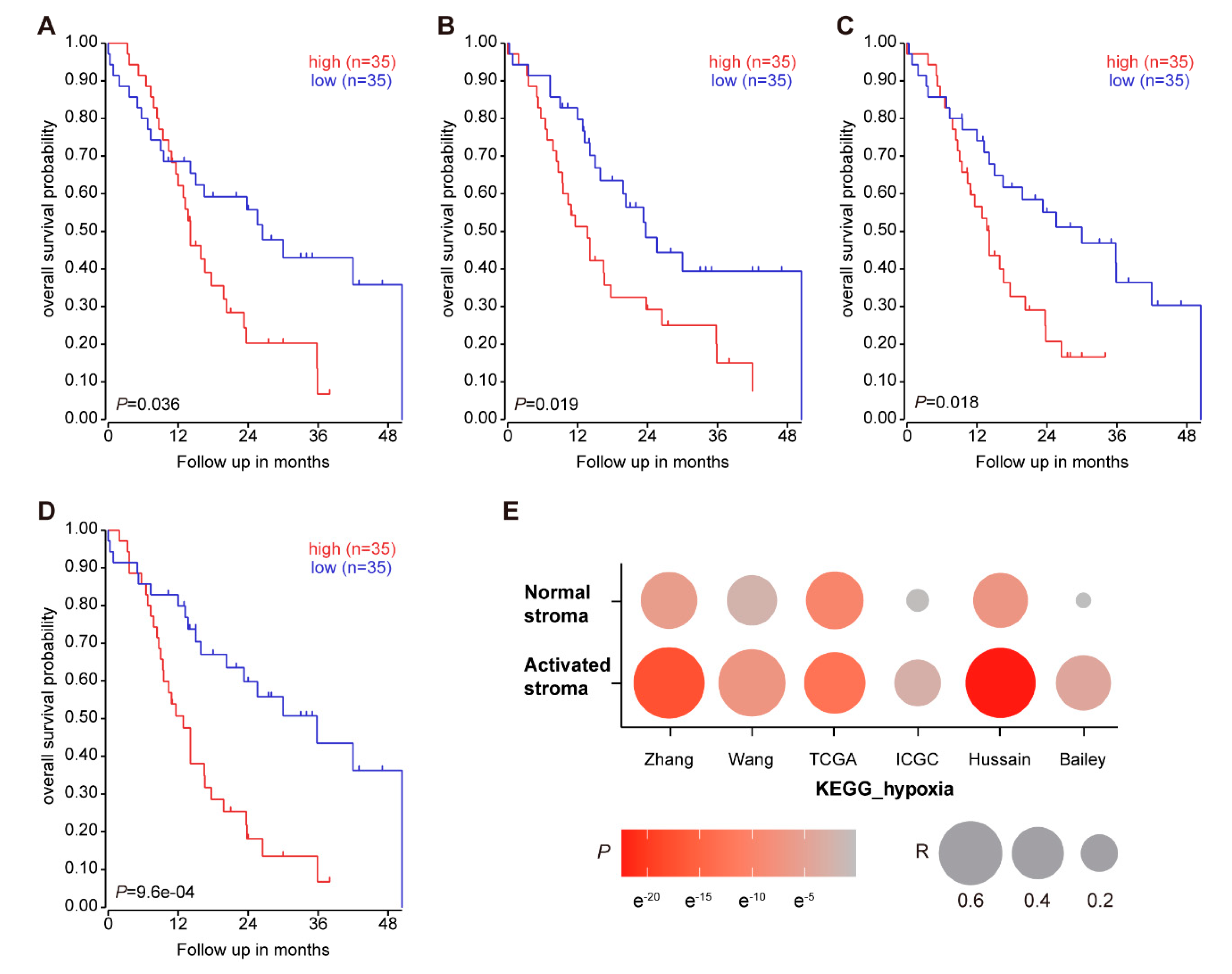
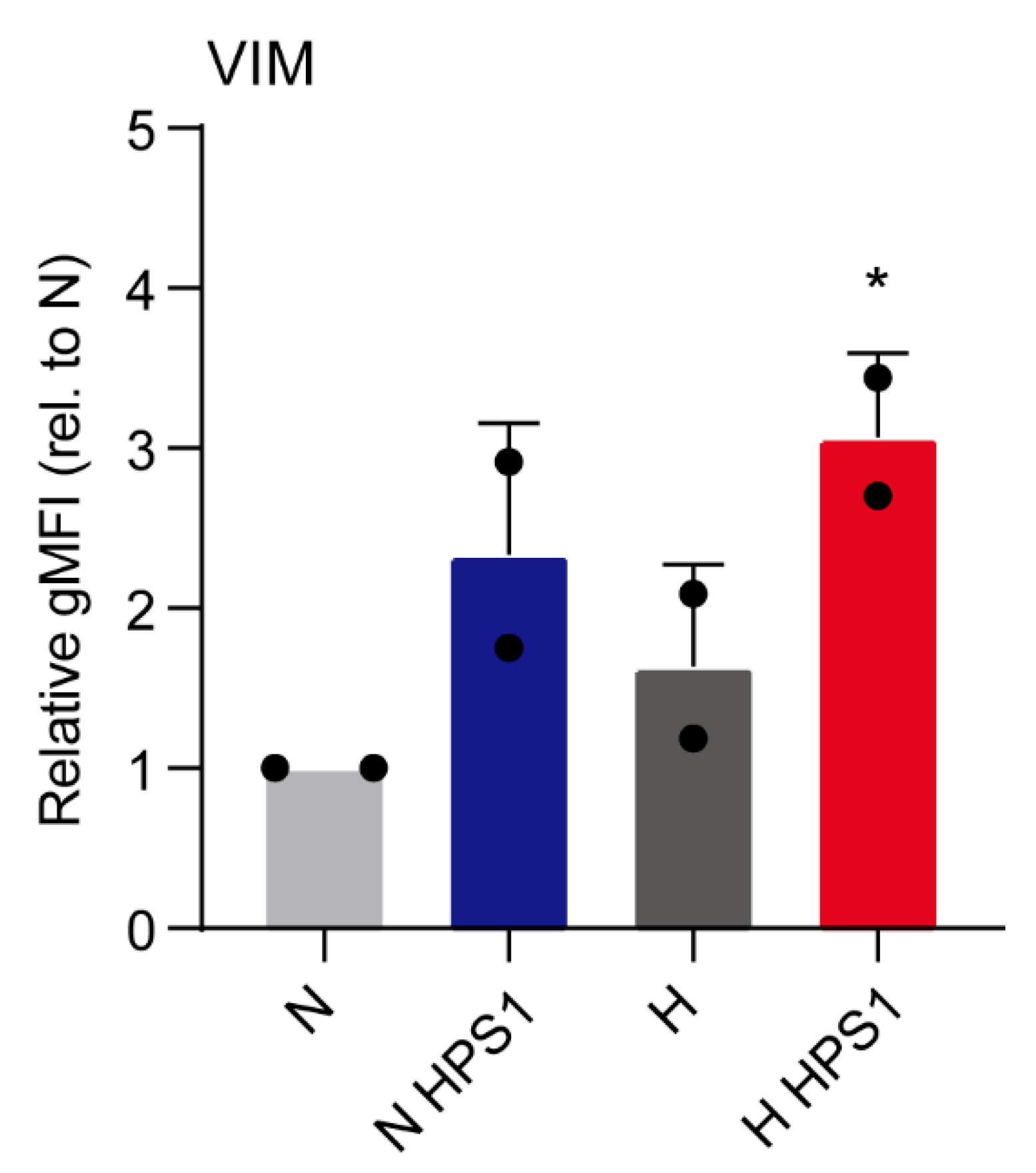
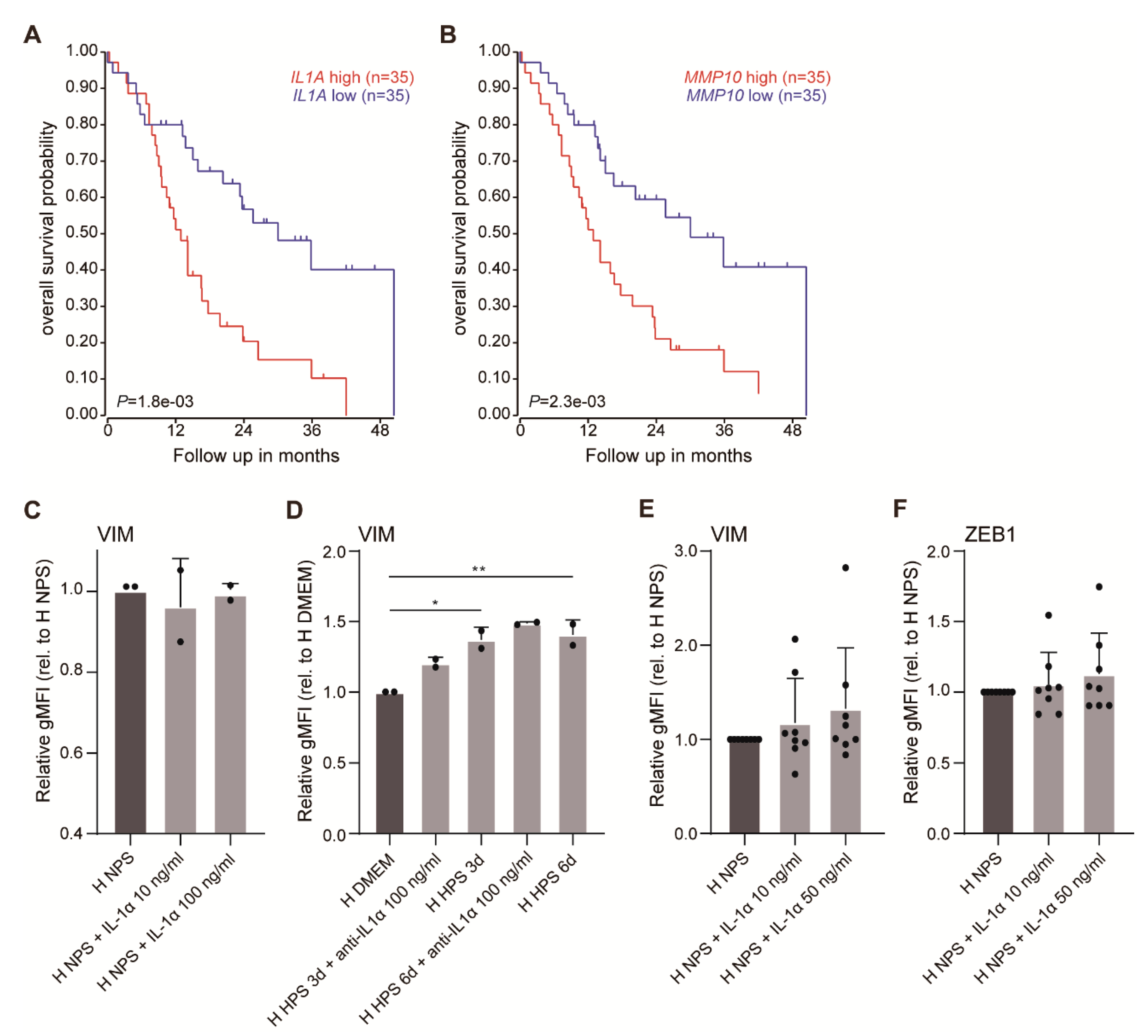
| Transcript | Sequence | |
|---|---|---|
| Forward | Reverse | |
| TIE1 | AAGCAGACAGACGTGATCTGG | GCACGATGAGCCGAAAGAAG |
| TEK | CAGGATACGAACCATGAAGATGC | GGGGCACTGAATGGATGAAG |
| TIMP4 | ATCTGTGCAACTACATCGAGC | CGAGATGGTACAGGGTACTGTG |
| BMP6 | CACCCGCTCAACCGCAAG | GTACTCCACCAGGTTCACAAAGC |
| TIMP1 | GGAATGCACAGTGTTTCCCTG | GGAAGCCCTTTTCAGAGCCT |
| FST | AGGCAAGATGTAAAGAGCAGC | CAGTAGGCATTATTGGTCTGGTC |
| MST1 | CCTGCCCCCTGAATGGTATG | CCCGTACCTTTGGTCTCACC |
| NRCAM | TAGAGTTAAAGCGGCTCCATACT | GGGTTGCCATTAGCTCTGC |
| CXCL16 | CTCTCCAGATCTGCCGGTT | CCTACCATGTTGTCAGGGGT |
| HGF | GACGCAGCTACAAGGGAACA | GCTCGAAGGCAAAAAGCTGTG |
| MMP10 | TGCTCTGCCTATCCTCTGAGT | TCACATCCTTTTCGAGGTTGTAG |
| FGF2 | TACAACTTCAAGCAGAAGAG | CAGCTCTTAGCAGACATTGG |
| IL1A | TGTATGTGACTGCCCAAGATG | TTAGTGCCGTGAGTTTCCC |
| BMP4 | CTTTACCGGCTTCAGTCTGG | GGGATGCTGCTGAGGTTAAA |
| Variable | Resected (n = 18) | Non-Resected (n = 24) | All (n = 42) |
|---|---|---|---|
| Age (Year) 1 | 63 (47–74) | 61 (47–74) | 62 (47–74) |
| Gender | |||
| Male | 12 | 15 | 27 |
| Female | 6 | 9 | 15 |
| Tumor location | |||
| Head | 16 | 16 | 32 |
| Corpus | 0 | 5 | 5 |
| Tail | 2 | 3 | 5 |
| M-Stage | |||
| M0 | 17 | 5 | 22 |
| M1 | 1 | 19 | 20 |
| Resection | |||
| No | 0 | 24 | 24 |
| R0 | 9 | 0 | 9 |
| R1 | 9 | 0 | 9 |
| Differentiation Grade | |||
| Moderate | 11 | 0 | 11 |
| Poor | 6 | 0 | 6 |
| Missing | 1 | 24 | 25 |
| Survival 2 | |||
| OS (Months) | 22 (16–41) | 9 (5–15) | 15 (7–24) |
| DFS (Days) | 468 (312–1237) | - | - |
| KEGG Hypoxia | Activated Stroma | Normal Stroma | ||||||
|---|---|---|---|---|---|---|---|---|
| AKT1 | EPO | PDHB | COL1A1 | PLAU | THY1 | DES | CCDC3 | PLP1 |
| AKT2 | ERBB2 | PDK1 | COL10A1 | LOXL1 | GFPT2 | ACTG2 | SPON1 | ADH1A |
| AKT3 | FLT1 | PFKFB3 | SULF1 | COL5A1 | SMOC2 | MYH11 | APOLD1 | CAV1 |
| ALDOA | GAPDH | PFKL | COL3A1 | FBN1 | CD163 | CNN1 | SPEG | VIT |
| ANGPT1 | HIF1A | PGK1 | CTHRC1 | COL4A2 | RGS1 | SCRG1 | PTGDS | GPM6B |
| ANGPT2 | HK1 | PIK3CA | COL1A2 | CILP | AIF1 | SMOC2 | A2M | FMO2 |
| ANGPT4 | HK2 | PIK3CB | SFRP4 | CTGF | PLAT | ATP1A2 | CPE | C1S |
| ARNT | HK3 | PIK3CD | SPARC | TYROBP | TNFAIP6 | SPARCL1 | AQP1 | CSRP2 |
| BCL2 | HKDC1 | PIK3R1 | COMP | C20orf103 | HLA-DRA | SYNM | RCAN2 | SFRP1 |
| CAMK2A | HMOX1 | PIK3R2 | INHBA | CD248 | TIMP1 | C10orf116 | PTX3 | KCNMB4 |
| CAMK2B | IFNG | PIK3R3 | FAP | MXRA5 | CNN1 | MYLK | RSPO3 | PPAP2A |
| CAMK2D | IFNGR1 | PLCG1 | MMP11 | ACTA2 | LZTS1 | WISP2 | FABP4 | PMP22 |
| CAMK2G | IFNGR2 | PLCG2 | COL11A1 | ASPN | IFI30 | ANGPTL7 | CPXM2 | LPL |
| CDKN1A | IGF1 | PRKCA | THBS2 | COL8A2 | NID2 | MGP | NR4A1 | DUSP1 |
| CDKN1B | IGF1R | PRKCB | SFRP2 | IGFBP7 | FSTL1 | IGF1 | CLDN5 | STON1 |
| CREBBP | IL6 | PRKCG | LUM | PDGFRB | PPAPDC1A | TAGLN | CXCL12 | DSTN |
| CUL2 | IL6R | RBX1 | POSTN | COL16A1 | ACP5 | CFD | COX7A1 | GSN |
| CYBB | INS | RELA | FNDC1 | C1S | F13A1 | SOD3 | OGN | CCL19 |
| EDN1 | INSR | RPS6 | CTSK | COL8A1 | MGP | ACTA2 | MYL9 | PDGFRL |
| EGF | LDHA | RPS6KB1 | CCL18 | COL5A2 | ITGBL1 | AOC3 | MYOC | PLA2G2A |
| EGFR | LTBR | RPS6KB2 | SPON2 | MMP9 | CYR61 | MFAP4 | SGCA | ADH1C |
| EGLN1 | MAP2K1 | SERPINE1 | SPP1 | THBS4 | PLA2G7 | C2orf40 | ADAMTS1 | THBS4 |
| EGLN2 | MAP2K2 | SLC2A1 | ISLR | COL12A1 | NCF2 | LMOD1 | ID4 | GNG11 |
| EGLN3 | MAPK1 | STAT3 | FN1 | CSF1R | LOXL2 | LHFP | CRYAB | SLN |
| EIF4E | MAPK3 | TEK | DCN | EGR2 | IL4I1 | LOC387763 | C7 | FSTL1 |
| EIF4E1B | MKNK1 | TF | VCAN | ITGA11 | RAB31 | VWF | CILP | LGI4 |
| EIF4E2 | MKNK2 | TFRC | IGH | LOC387763 | LGALS1 | CLEC3B | RERGL | GPX3 |
| EIF4EBP1 | MTOR | TIPM1 | SPON1 | HTRA1 | VSIG4 | ITGA7 | PPP1R14A | MUSTN1 |
| ELOB | NFKB1 | TLR4 | MMP7 | VIM | NOX4 | GPIHBP1 | TPM2 | S100B |
| ELOC | NOS2 | VEGFA | CDH11 | HLA-DPB1 | ALOX5AP | HBB | CRLF1 | RPS4Y1 |
| ENO1 | NOS3 | VHL | MFAP5 | NNMT | CXCR4 | EFEMP1 | HSPB2 | ABCA8 |
| ENO2 | NPPA | GREM1 | HTRA3 | AEBP1 | RBP7 | PLN | IL33 | |
| ENO3 | PDHA1 | ZNF469 | TMEM204 | SRPX | NEXN | |||
| EP300 | PDHA2 | FCGR3A | FMOD | DCN | FMOD | |||
| Genesets | Semenza Hif1 Targets ** | |
|---|---|---|
| Low | High | |
| bmp receptor signaling | ||
| Low | 20.3 (n = 19) | 9 (n = 13) |
| High | 22.65 (n = 16) | 16.55 (n = 22) |
| regulation of bmp signaling pathway | ||
| Low | 24 (n = 17) | 8.1 (n = 12) |
| High | 18.1 (n = 18) | 14.1 (n = 23) |
| response to bmp | ||
| Low | 20 (n = 16) | 8.7 (n = 13) |
| High | 23.3 (n = 19) | 14.1 (n = 22) |
| signaling by bmp | ||
| Low | 18 (n = 17) | 11.25 (n = 18) |
| High | 24.45 (n = 18) | 11 (n = 17) |
| reactome signaling by bmp | ||
| Low | 18 (n = 19) | 10.2 (n = 16) |
| High | 24.45 (n = 16) | 11.6 (n = 19) |
References
- Siegel, R.L.; Miller, K.D.; Jemal, A. Cancer statistics, 2019. CA Cancer J. Clin. 2019, 69, 7–34. [Google Scholar] [CrossRef] [PubMed]
- Xu, Z.; Pothula, S.P.; Wilson, J.S.; Apte, M.V. Pancreatic cancer and its stroma: A conspiracy theory. World J. Gastroenterol. 2014, 20, 11216–11229. [Google Scholar] [CrossRef] [PubMed]
- Cohen, R.; Neuzillet, C.; Tijeras-Raballand, A.; Faivre, S.; de Gramont, A.; Raymond, E. Targeting cancer cell metabolism in pancreatic adenocarcinoma. Oncotarget 2015, 6, 16832–16847. [Google Scholar] [CrossRef]
- Viale, A.; Pettazzoni, P.; Lyssiotis, C.A.; Ying, H.; Sanchez, N.; Marchesini, M.; Carugo, A.; Green, T.; Seth, S.; Giuliani, V.; et al. Oncogene ablation-resistant pancreatic cancer cells depend on mitochondrial function. Nature 2014, 514, 628–632. [Google Scholar] [CrossRef] [PubMed]
- Erkan, M.; Hausmann, S.; Michalski, C.W.; Fingerle, A.A.; Dobritz, M.; Kleeff, J.; Friess, H. The role of stroma in pancreatic cancer: Diagnostic and therapeutic implications. Nat. Rev. Gastroenterol. Hepatol. 2012, 9, 454–467. [Google Scholar] [CrossRef] [PubMed]
- Apte, M.V.; Park, S.; Phillips, P.A.; Santucci, N.; Goldstein, D.; Kumar, R.K.; Ramm, G.A.; Buchler, M.; Friess, H.; McCarroll, J.A.; et al. Desmoplastic reaction in pancreatic cancer: Role of pancreatic stellate cells. Pancreas 2004, 29, 179–187. [Google Scholar] [CrossRef] [PubMed]
- Liu, Y.; Du, L. Role of pancreatic stellate cells and periostin in pancreatic cancer progression. Tumour Biol. 2015, 36, 3171–3177. [Google Scholar] [CrossRef] [PubMed]
- Apte, M.V.; Wilson, J.S.; Lugea, A.; Pandol, S.J. A starring role for stellate cells in the pancreatic cancer microenvironment. Gastroenterology 2013, 144, 1210–1219. [Google Scholar] [CrossRef] [PubMed]
- Dauer, P.; Nomura, A.; Saluja, A.; Banerjee, S. Microenvironment in determining chemo-resistance in pancreatic cancer: Neighborhood matters. Pancreatology 2017, 17, 7–12. [Google Scholar] [CrossRef]
- Masamune, A.; Shimosegawa, T. Signal transduction in pancreatic stellate cells. J. Gastroenterol. 2009, 44, 249–260. [Google Scholar] [CrossRef]
- Erkan, M.; Reiser-Erkan, C.; Michalski, C.W.; Deucker, S.; Sauliunaite, D.; Streit, S.; Esposito, I.; Friess, H.; Kleeff, J. Cancer-stellate cell interactions perpetuate the hypoxia-fibrosis cycle in pancreatic ductal adenocarcinoma. Neoplasia 2009, 11, 497–508. [Google Scholar] [CrossRef]
- Masamune, A.; Kikuta, K.; Watanabe, T.; Satoh, K.; Hirota, M.; Shimosegawa, T. Hypoxia stimulates pancreatic stellate cells to induce fibrosis and angiogenesis in pancreatic cancer. Am. J. Physiol. Gastrointest Liver Physiol. 2008, 295, G709–G717. [Google Scholar] [CrossRef] [PubMed]
- Neesse, A.; Michl, P.; Frese, K.K.; Feig, C.; Cook, N.; Jacobetz, M.A.; Lolkema, M.P.; Buchholz, M.; Olive, K.P.; Gress, T.M.; et al. Stromal biology and therapy in pancreatic cancer. Gut 2011, 60, 861–868. [Google Scholar] [CrossRef] [PubMed]
- Feig, C.; Gopinathan, A.; Neesse, A.; Chan, D.S.; Cook, N.; Tuveson, D.A. The pancreas cancer microenvironment. Clin. Cancer Res. 2012, 18, 4266–4276. [Google Scholar] [CrossRef] [PubMed]
- Provenzano, P.P.; Cuevas, C.; Chang, A.E.; Goel, V.K.; Von Hoff, D.D.; Hingorani, S.R. Enzymatic targeting of the stroma ablates physical barriers to treatment of pancreatic ductal adenocarcinoma. Cancer Cell 2012, 21, 418–429. [Google Scholar] [CrossRef] [PubMed]
- Koong, A.C.; Mehta, V.K.; Le, Q.T.; Fisher, G.A.; Terris, D.J.; Brown, J.M.; Bastidas, A.J.; Vierra, M. Pancreatic tumors show high levels of hypoxia. Int. J. Radiat Oncol. Biol. Phys. 2000, 48, 919–922. [Google Scholar] [CrossRef]
- Jacobetz, M.A.; Chan, D.S.; Neesse, A.; Bapiro, T.E.; Cook, N.; Frese, K.K.; Feig, C.; Nakagawa, T.; Caldwell, M.E.; Zecchini, H.I.; et al. Hyaluronan impairs vascular function and drug delivery in a mouse model of pancreatic cancer. Gut 2013, 62, 112–120. [Google Scholar] [CrossRef]
- Onishi, H.; Morifuji, Y.; Kai, M.; Suyama, K.; Iwasaki, H.; Katano, M. Hedgehog inhibitor decreases chemosensitivity to 5-fluorouracil and gemcitabine under hypoxic conditions in pancreatic cancer. Cancer Sci. 2012, 103, 1272–1279. [Google Scholar] [CrossRef]
- Maftouh, M.; Avan, A.; Sciarrillo, R.; Granchi, C.; Leon, L.G.; Rani, R.; Funel, N.; Smid, K.; Honeywell, R.; Boggi, U.; et al. Synergistic interaction of novel lactate dehydrogenase inhibitors with gemcitabine against pancreatic cancer cells in hypoxia. Br. J. Cancer 2014, 110, 172–182. [Google Scholar] [CrossRef]
- Onishi, H.; Kai, M.; Odate, S.; Iwasaki, H.; Morifuji, Y.; Ogino, T.; Morisaki, T.; Nakashima, Y.; Katano, M. Hypoxia activates the hedgehog signaling pathway in a ligand-independent manner by upregulation of Smo transcription in pancreatic cancer. Cancer Sci. 2011, 102, 1144–1150. [Google Scholar] [CrossRef]
- Majmundar, A.J.; Wong, W.J.; Simon, M.C. Hypoxia-inducible factors and the response to hypoxic stress. Mol. Cell 2010, 40, 294–309. [Google Scholar] [CrossRef] [PubMed]
- Semenza, G.L. HIF-1 mediates metabolic responses to intratumoral hypoxia and oncogenic mutations. J. Clin. Invest. 2013, 123, 3664–3671. [Google Scholar] [CrossRef] [PubMed]
- Guillaumond, F.; Leca, J.; Olivares, O.; Lavaut, M.N.; Vidal, N.; Berthezene, P.; Dusetti, N.J.; Loncle, C.; Calvo, E.; Turrini, O.; et al. Strengthened glycolysis under hypoxia supports tumor symbiosis and hexosamine biosynthesis in pancreatic adenocarcinoma. Proc. Natl. Acad. Sci. USA 2013, 110, 3919–3924. [Google Scholar] [CrossRef] [PubMed]
- Zhang, J.J.; Wu, H.S.; Wang, L.; Tian, Y.; Zhang, J.H.; Wu, H.L. Expression and significance of TLR4 and HIF-1alpha in pancreatic ductal adenocarcinoma. World J. Gastroenterol. 2010, 16, 2881–2888. [Google Scholar] [CrossRef]
- Park, M.S.; Klotz, E.; Kim, M.J.; Song, S.Y.; Park, S.W.; Cha, S.W.; Lim, J.S.; Seong, J.; Chung, J.B.; Kim, K.W. Perfusion CT: Noninvasive surrogate marker for stratification of pancreatic cancer response to concurrent chemo- and radiation therapy. Radiology 2009, 250, 110–117. [Google Scholar] [CrossRef] [PubMed]
- Wang, W.; Reiser-Erkan, C.; Michalski, C.W.; Raggi, M.C.; Quan, L.; Yupei, Z.; Friess, H.; Erkan, M.; Kleeff, J. Hypoxia inducible BHLHB2 is a novel and independent prognostic marker in pancreatic ductal adenocarcinoma. Biochem. Biophys. Res. Commun. 2010, 401, 422–428. [Google Scholar] [CrossRef]
- Zhu, S.; Zhou, Y.; Wang, L.; Zhang, J.; Wu, H.; Xiong, J.; Zhang, J.; Tian, Y.; Wang, C.; Wu, H. Transcriptional upregulation of MT2-MMP in response to hypoxia is promoted by HIF-1α in cancer cells. Mol. Carcinog. 2011, 50, 770–780. [Google Scholar] [CrossRef]
- Klaassen, R.; Bennink, R.J.; van Tienhoven, G.; Bijlsma, M.F.; Besselink, M.G.; van Berge Henegouwen, M.I.; Wilmink, J.W.; Nederveen, A.J.; Windhorst, A.D.; Hulshof, M.C.; et al. Feasibility and repeatability of PET with the hypoxia tracer [(18)F]HX4 in oesophageal and pancreatic cancer. Radiother Oncol. 2015, 116, 94–99. [Google Scholar] [CrossRef][Green Version]
- Versteijne, E.; van Eijck, C.H.; Punt, C.J.; Suker, M.; Zwinderman, A.H.; Dohmen, M.A.; Groothuis, K.B.; Busch, O.R.; Besselink, M.G.; de Hingh, I.H.; et al. Preoperative radiochemotherapy versus immediate surgery for resectable and borderline resectable pancreatic cancer (PREOPANC trial): Study protocol for a multicentre randomized controlled trial. Trials 2016, 17, 127. [Google Scholar] [CrossRef]
- Versteijne, E.; Suker, M.; Groothuis, K.; Akkermans-Vogelaar, J.M.; Besselink, M.G.; Bonsing, B.A.; Buijsen, J.; Busch, O.R.; Creemers, G.M.; van Dam, R.M.; et al. Preoperative Chemoradiotherapy Versus Immediate Surgery for Resectable and Borderline Resectable Pancreatic Cancer: Results of the Dutch Randomized Phase III PREOPANC Trial. J. Clin. Oncol. 2020, 38, 1763–1773. [Google Scholar] [CrossRef]
- Klaassen, R.; Steins, A.; Gurney-Champion, O.J.; Bijlsma, M.F.; van Tienhoven, G.; Engelbrecht, M.R.W.; van Eijck, C.H.J.; Suker, M.; Wilmink, J.W.; Besselink, M.G.; et al. Pathological validation and prognostic potential of quantitative MRI in the characterization of pancreas cancer: Preliminary experience. Mol. Oncol. 2020. [Google Scholar] [CrossRef] [PubMed]
- Damhofer, H.; Ebbing, E.A.; Steins, A.; Welling, L.; Tol, J.A.; Krishnadath, K.K.; van Leusden, T.; van de Vijver, M.J.; Besselink, M.G.; Busch, O.R.; et al. Establishment of patient-derived xenograft models and cell lines for malignancies of the upper gastrointestinal tract. J. Transl. Med. 2015, 13, 115. [Google Scholar] [CrossRef] [PubMed]
- Ebbing, E.A.; Steins, A.; Fessler, E.; Stathi, P.; Lesterhuis, W.J.; Krishnadath, K.K.; Vermeulen, L.; Medema, J.P.; Bijlsma, M.F.; van Laarhoven, H.W.M. Esophageal Adenocarcinoma Cells and Xenograft Tumors Exposed to Erb-b2 Receptor Tyrosine Kinase 2 and 3 Inhibitors Activate Transforming Growth Factor Beta Signaling, Which Induces Epithelial to Mesenchymal Transition. Gastroenterology 2017, 153, 63–76.e14. [Google Scholar] [CrossRef] [PubMed]
- Perez-Mancera, P.A.; Rust, A.G.; van der Weyden, L.; Kristiansen, G.; Li, A.; Sarver, A.L.; Silverstein, K.A.; Grutzmann, R.; Aust, D.; Rummele, P.; et al. The deubiquitinase USP9X suppresses pancreatic ductal adenocarcinoma. Nature 2012, 486, 266–270. [Google Scholar] [CrossRef] [PubMed]
- Zhang, G.; He, P.; Tan, H.; Budhu, A.; Gaedcke, J.; Ghadimi, B.M.; Ried, T.; Yfantis, H.G.; Lee, D.H.; Maitra, A.; et al. Integration of metabolomics and transcriptomics revealed a fatty acid network exerting growth inhibitory effects in human pancreatic cancer. Clin. Cancer Res. 2013, 19, 4983–4993. [Google Scholar] [CrossRef]
- Yang, S.; He, P.; Wang, J.; Schetter, A.; Tang, W.; Funamizu, N.; Yanaga, K.; Uwagawa, T.; Satoskar, A.R.; Gaedcke, J.; et al. A Novel MIF Signaling Pathway Drives the Malignant Character of Pancreatic Cancer by Targeting NR3C2. Cancer Res. 2016, 76, 3838–3850. [Google Scholar] [CrossRef]
- Raphael, B.J.; Hruban, R.H.; Aguirre, A.J.; Moffitt, R.A.; Yeh, J.J.; Stewart, C.; Robertson, A.G.; Cherniack, A.D.; Gupta, M.; Getz, G.; et al. Integrated Genomic Characterization of Pancreatic Ductal Adenocarcinoma. Cancer Cell 2017, 32, 185–203 e113. [Google Scholar] [CrossRef]
- Pei, H.; Li, L.; Fridley, B.L.; Jenkins, G.D.; Kalari, K.R.; Lingle, W.; Petersen, G.; Lou, Z.; Wang, L. FKBP51 affects cancer cell response to chemotherapy by negatively regulating Akt. Cancer Cell 2009, 16, 259–266. [Google Scholar] [CrossRef]
- Bailey, P.; Chang, D.K.; Nones, K.; Johns, A.L.; Patch, A.M.; Gingras, M.C.; Miller, D.K.; Christ, A.N.; Bruxner, T.J.; Quinn, M.C.; et al. Genomic analyses identify molecular subtypes of pancreatic cancer. Nature 2016, 531, 47–52. [Google Scholar] [CrossRef]
- Moffitt, R.A.; Marayati, R.; Flate, E.L.; Volmar, K.E.; Loeza, S.G.; Hoadley, K.A.; Rashid, N.U.; Williams, L.A.; Eaton, S.C.; Chung, A.H.; et al. Virtual microdissection identifies distinct tumor- and stroma-specific subtypes of pancreatic ductal adenocarcinoma. Nat. Genet 2015, 47, 1168–1178. [Google Scholar] [CrossRef]
- Dijk, F.; Veenstra, V.L.; Soer, E.C.; Dings, M.P.G.; Zhao, L.; Halfwerk, J.B.; Hooijer, G.K.; Damhofer, H.; Marzano, M.; Steins, A.; et al. Unsupervised class discovery in pancreatic ductal adenocarcinoma reveals cell-intrinsic mesenchymal features and high concordance between existing classification systems. Sci. Rep. 2020, 10, 337. [Google Scholar] [CrossRef] [PubMed]
- The Gene Ontology, C. The Gene Ontology Resource: 20 years and still GOing strong. Nucleic Acids Res. 2019, 47, D330–D338. [Google Scholar] [CrossRef]
- Wu, G.; Haw, R. Functional Interaction Network Construction and Analysis for Disease Discovery. Methods Mol. Biol. 2017, 1558, 235–253. [Google Scholar] [CrossRef] [PubMed]
- Fabregat, A.; Sidiropoulos, K.; Viteri, G.; Marin-Garcia, P.; Ping, P.; Stein, L.; D’Eustachio, P.; Hermjakob, H. Reactome diagram viewer: Data structures and strategies to boost performance. Bioinformatics 2018, 34, 1208–1214. [Google Scholar] [CrossRef] [PubMed]
- Sidiropoulos, K.; Viteri, G.; Sevilla, C.; Jupe, S.; Webber, M.; Orlic-Milacic, M.; Jassal, B.; May, B.; Shamovsky, V.; Duenas, C.; et al. Reactome enhanced pathway visualization. Bioinformatics 2017, 33, 3461–3467. [Google Scholar] [CrossRef]
- Jassal, B.; Matthews, L.; Viteri, G.; Gong, C.; Lorente, P.; Fabregat, A.; Sidiropoulos, K.; Cook, J.; Gillespie, M.; Haw, R.; et al. The reactome pathway knowledgebase. Nucleic Acids Res. 2020, 48, D498–D503. [Google Scholar] [CrossRef]
- Semenza, G.L. Hypoxia-inducible factor 1: Oxygen homeostasis and disease pathophysiology. Trends Mol. Med. 2001, 7, 345–350. [Google Scholar] [CrossRef]
- Cerami, E.G.; Gross, B.E.; Demir, E.; Rodchenkov, I.; Babur, O.; Anwar, N.; Schultz, N.; Bader, G.D.; Sander, C. Pathway Commons, a web resource for biological pathway data. Nucleic Acids Res. 2011, 39, D685–D690. [Google Scholar] [CrossRef]
- Schaefer, C.F.; Anthony, K.; Krupa, S.; Buchoff, J.; Day, M.; Hannay, T.; Buetow, K.H. PID: The Pathway Interaction Database. Nucleic Acids Res. 2009, 37, D674–D679. [Google Scholar] [CrossRef]
- Goumans, M.J.; Zwijsen, A.; Ten Dijke, P.; Bailly, S. Bone Morphogenetic Proteins in Vascular Homeostasis and Disease. Cold Spring Harb. Perspect. Biol. 2018, 10. [Google Scholar] [CrossRef]
- Miyazono, K.; Kamiya, Y.; Morikawa, M. Bone morphogenetic protein receptors and signal transduction. J. Biochem. 2010, 147, 35–51. [Google Scholar] [CrossRef]
- Chen, D.; Zhao, M.; Mundy, G.R. Bone morphogenetic proteins. Growth Factors 2004, 22, 233–241. [Google Scholar] [CrossRef]
- Budczies, J.; Klauschen, F.; Sinn, B.V.; Gyorffy, B.; Schmitt, W.D.; Darb-Esfahani, S.; Denkert, C. Cutoff Finder: A comprehensive and straightforward Web application enabling rapid biomarker cutoff optimization. PLoS ONE 2012, 7, e51862. [Google Scholar] [CrossRef]
- Damhofer, H.; Medema, J.P.; Veenstra, V.L.; Badea, L.; Popescu, I.; Roelink, H.; Bijlsma, M.F. Assessment of the stromal contribution to Sonic Hedgehog-dependent pancreatic adenocarcinoma. Mol. Oncol. 2013, 7, 1031–1042. [Google Scholar] [CrossRef]
- Hong, Y.; Zhang, Q. Phenotype of circulating tumor cell: Face-off between epithelial and mesenchymal masks. Tumour Biol. 2016, 37, 5663–5674. [Google Scholar] [CrossRef]
- Deryugina, E.I.; Quigley, J.P. Matrix metalloproteinases and tumor metastasis. Cancer Metastasis Rev. 2006, 25, 9–34. [Google Scholar] [CrossRef]
- Smith, B.N.; Bhowmick, N.A. Role of EMT in Metastasis and Therapy Resistance. J. Clin. Med. 2016, 5, 17. [Google Scholar] [CrossRef]
- Quail, D.F.; Joyce, J.A. Microenvironmental regulation of tumor progression and metastasis. Nat. Med. 2013, 19, 1423–1437. [Google Scholar] [CrossRef] [PubMed]
- Dubois, L.J.; Lieuwes, N.G.; Janssen, M.H.; Peeters, W.J.; Windhorst, A.D.; Walsh, J.C.; Kolb, H.C.; Ollers, M.C.; Bussink, J.; van Dongen, G.A.; et al. Preclinical evaluation and validation of [18F]HX4, a promising hypoxia marker for PET imaging. Proc. Natl. Acad. Sci. USA 2011, 108, 14620–14625. [Google Scholar] [CrossRef]
- Zhang, Q.; Lou, Y.; Zhang, J.; Fu, Q.; Wei, T.; Sun, X.; Chen, Q.; Yang, J.; Bai, X.; Liang, T. Hypoxia-inducible factor-2α promotes tumor progression and has crosstalk with Wnt/β-catenin signaling in pancreatic cancer. Mol. Cancer 2017, 16, 119. [Google Scholar] [CrossRef]
- Ide, T.; Kitajima, Y.; Miyoshi, A.; Ohtsuka, T.; Mitsuno, M.; Ohtaka, K.; Miyazaki, K. The hypoxic environment in tumor-stromal cells accelerates pancreatic cancer progression via the activation of paracrine hepatocyte growth factor/c-Met signaling. Ann. Surg. Oncol. 2007, 14, 2600–2607. [Google Scholar] [CrossRef]
- Tjomsland, V.; Spangeus, A.; Valila, J.; Sandstrom, P.; Borch, K.; Druid, H.; Falkmer, S.; Falkmer, U.; Messmer, D.; Larsson, M. Interleukin 1alpha sustains the expression of inflammatory factors in human pancreatic cancer microenvironment by targeting cancer-associated fibroblasts. Neoplasia 2011, 13, 664–675. [Google Scholar] [CrossRef]
- Apte, R.N.; Dotan, S.; Elkabets, M.; White, M.R.; Reich, E.; Carmi, Y.; Song, X.; Dvozkin, T.; Krelin, Y.; Voronov, E. The involvement of IL-1 in tumorigenesis, tumor invasiveness, metastasis and tumor-host interactions. Cancer Metastasis Rev. 2006, 25, 387–408. [Google Scholar] [CrossRef]
- Zhuang, Z.; Ju, H.Q.; Aguilar, M.; Gocho, T.; Li, H.; Iida, T.; Lee, H.; Fan, X.; Zhou, H.; Ling, J.; et al. IL1 Receptor Antagonist Inhibits Pancreatic Cancer Growth by Abrogating NF-kappaB Activation. Clin. Cancer Res. 2016, 22, 1432–1444. [Google Scholar] [CrossRef]
- Biffi, G.; Oni, T.E.; Spielman, B.; Hao, Y.; Elyada, E.; Park, Y.; Preall, J.; Tuveson, D.A. IL1-Induced JAK/STAT Signaling Is Antagonized by TGFβ to Shape CAF Heterogeneity in Pancreatic Ductal Adenocarcinoma. Cancer Discov. 2019, 9, 282–301. [Google Scholar] [CrossRef]
- Ling, J.; Chiao, P.J. Two Birds with One Stone: Therapeutic Targeting of IL1alpha Signaling Pathways in Pancreatic Ductal Adenocarcinoma and the Cancer-Associated Fibroblasts. Cancer Discov. 2019, 9, 173–175. [Google Scholar] [CrossRef]
- Leppanen, V.M.; Saharinen, P.; Alitalo, K. Structural basis of Tie2 activation and Tie2/Tie1 heterodimerization. Proc. Natl. Acad. Sci. USA 2017, 114, 4376–4381. [Google Scholar] [CrossRef]
- Savant, S.; La Porta, S.; Budnik, A.; Busch, K.; Hu, J.; Tisch, N.; Korn, C.; Valls, A.F.; Benest, A.V.; Terhardt, D.; et al. The Orphan Receptor Tie1 Controls Angiogenesis and Vascular Remodeling by Differentially Regulating Tie2 in Tip and Stalk Cells. Cell Rep. 2015, 12, 1761–1773. [Google Scholar] [CrossRef]
- Korhonen, E.A.; Lampinen, A.; Giri, H.; Anisimov, A.; Kim, M.; Allen, B.; Fang, S.; D’Amico, G.; Sipila, T.J.; Lohela, M.; et al. Tie1 controls angiopoietin function in vascular remodeling and inflammation. J. Clin. Invest. 2016, 126, 3495–3510. [Google Scholar] [CrossRef] [PubMed]
- Schnegg, C.I.; Yang, M.H.; Ghosh, S.K.; Hsu, M.Y. Induction of Vasculogenic Mimicry Overrides VEGF-A Silencing and Enriches Stem-like Cancer Cells in Melanoma. Cancer Res. 2015, 75, 1682–1690. [Google Scholar] [CrossRef] [PubMed]
- Tiainen, L.; Korhonen, E.A.; Leppanen, V.M.; Luukkaala, T.; Hamalainen, M.; Tanner, M.; Lahdenpera, O.; Vihinen, P.; Jukkola, A.; Karihtala, P.; et al. High baseline Tie1 level predicts poor survival in metastatic breast cancer. BMC Cancer 2019, 19, 732. [Google Scholar] [CrossRef]
- Lin, W.C.; Li, A.F.; Chi, C.W.; Chung, W.W.; Huang, C.L.; Lui, W.Y.; Kung, H.J.; Wu, C.W. tie-1 protein tyrosine kinase: A novel independent prognostic marker for gastric cancer. Clin. Cancer Res. 1999, 5, 1745–1751. [Google Scholar] [PubMed]
- Sinn, M.; Denkert, C.; Striefler, J.K.; Pelzer, U.; Stieler, J.M.; Bahra, M.; Lohneis, P.; Dorken, B.; Oettle, H.; Riess, H.; et al. alpha-Smooth muscle actin expression and desmoplastic stromal reaction in pancreatic cancer: Results from the CONKO-001 study. Br. J. Cancer 2014, 111, 1917–1923. [Google Scholar] [CrossRef]
- Bramhall, S.R.; Schulz, J.; Nemunaitis, J.; Brown, P.D.; Baillet, M.; Buckels, J.A. A double-blind placebo-controlled, randomised study comparing gemcitabine and marimastat with gemcitabine and placebo as first line therapy in patients with advanced pancreatic cancer. Br. J. Cancer 2002, 87, 161–167. [Google Scholar] [CrossRef]
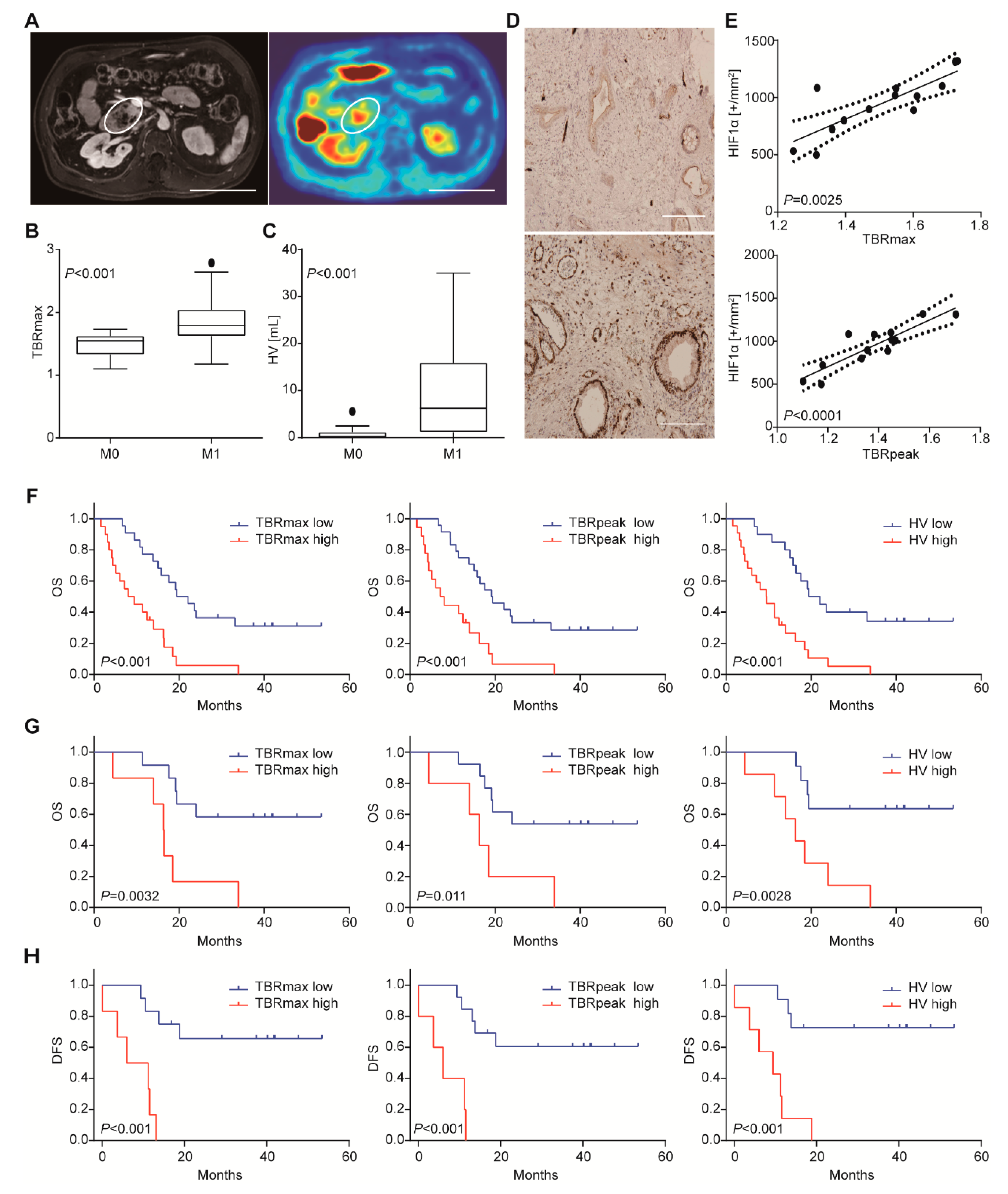
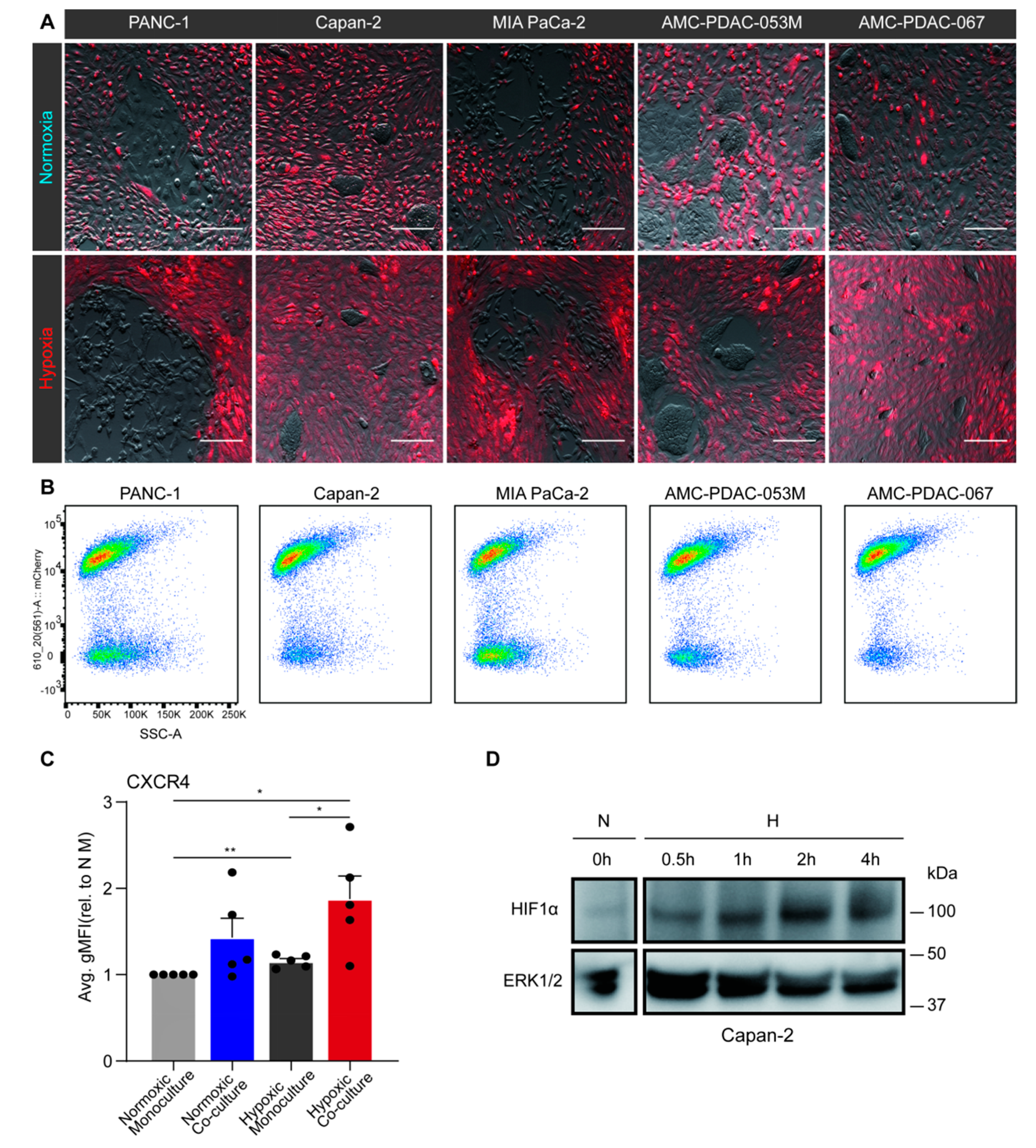
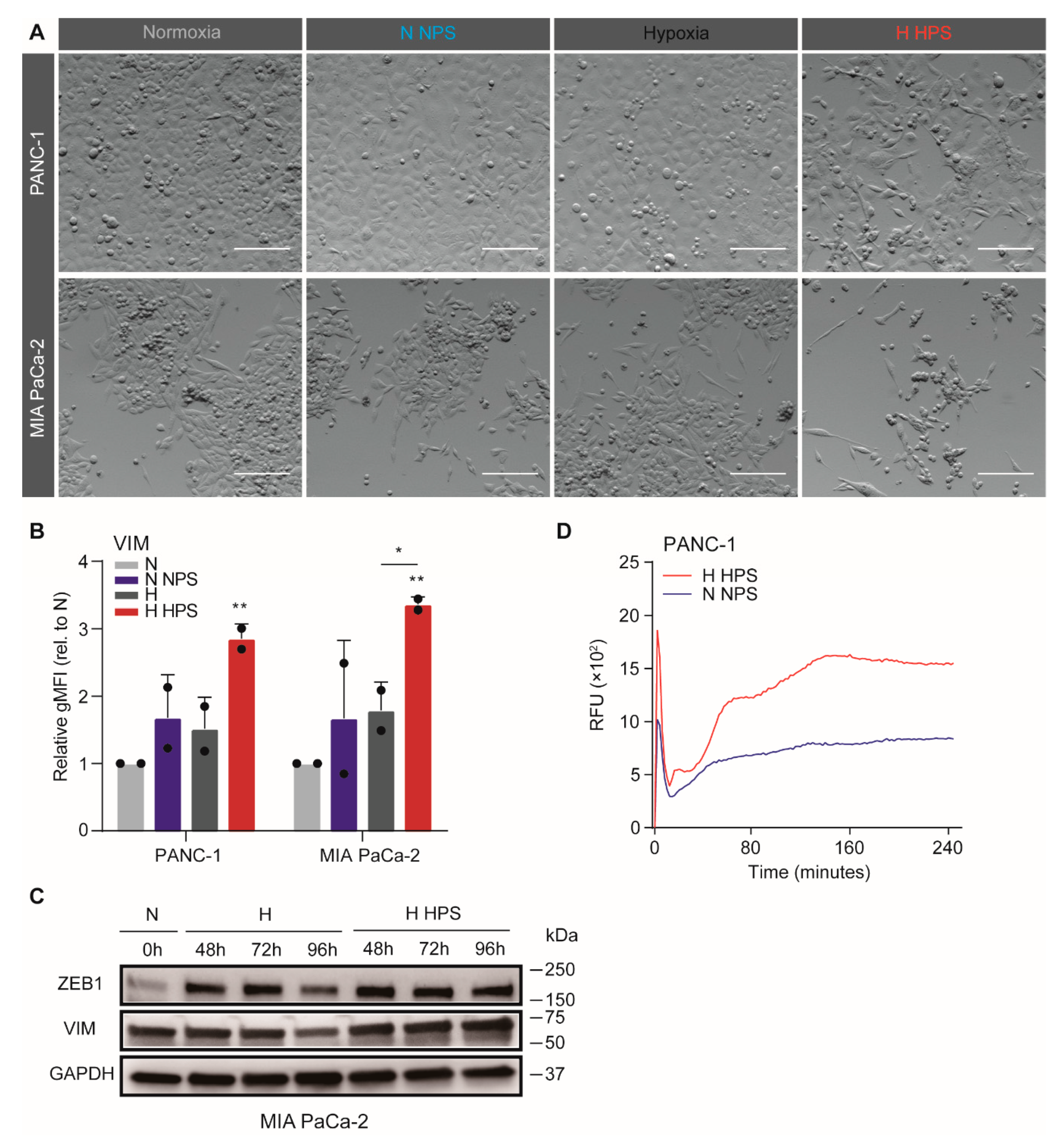

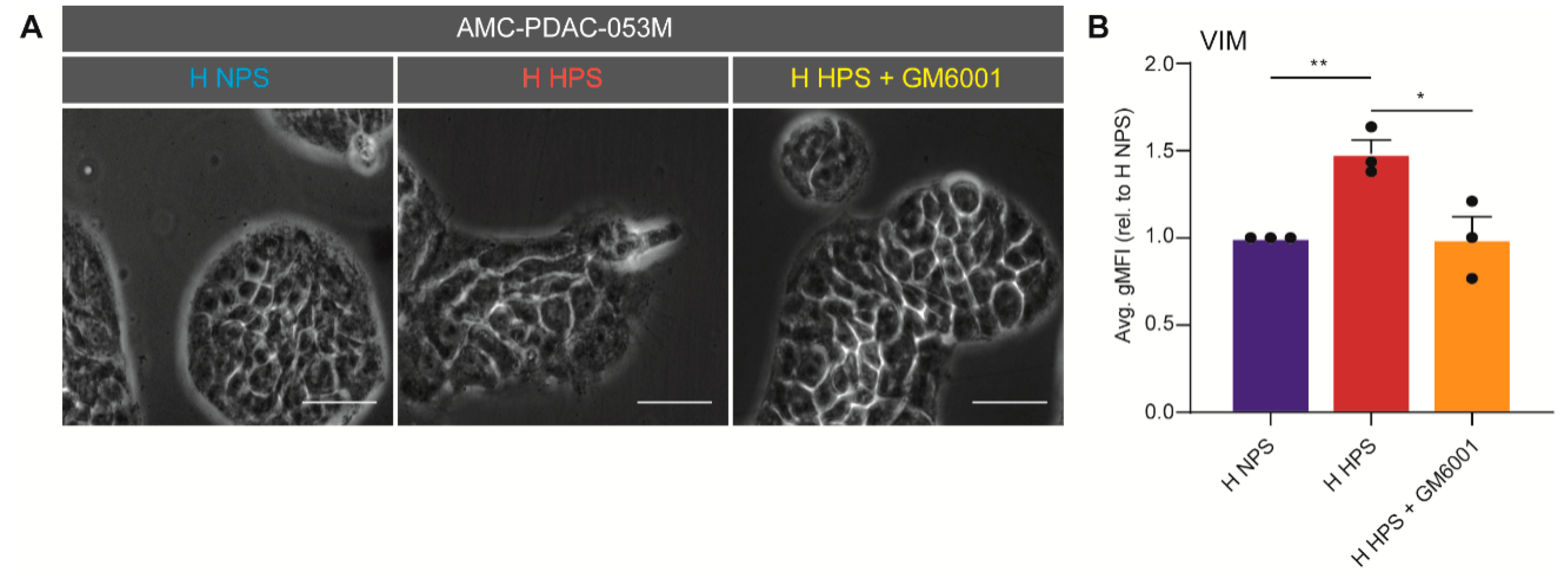
Publisher’s Note: MDPI stays neutral with regard to jurisdictional claims in published maps and institutional affiliations. |
© 2020 by the authors. Licensee MDPI, Basel, Switzerland. This article is an open access article distributed under the terms and conditions of the Creative Commons Attribution (CC BY) license (http://creativecommons.org/licenses/by/4.0/).
Share and Cite
Liu, D.; Steins, A.; Klaassen, R.; van der Zalm, A.P.; Bennink, R.J.; van Tienhoven, G.; Besselink, M.G.; Bijlsma, M.F.; van Laarhoven, H.W.M. Soluble Compounds Released by Hypoxic Stroma Confer Invasive Properties to Pancreatic Ductal Adenocarcinoma. Biomedicines 2020, 8, 444. https://doi.org/10.3390/biomedicines8110444
Liu D, Steins A, Klaassen R, van der Zalm AP, Bennink RJ, van Tienhoven G, Besselink MG, Bijlsma MF, van Laarhoven HWM. Soluble Compounds Released by Hypoxic Stroma Confer Invasive Properties to Pancreatic Ductal Adenocarcinoma. Biomedicines. 2020; 8(11):444. https://doi.org/10.3390/biomedicines8110444
Chicago/Turabian StyleLiu, Dajia, Anne Steins, Remy Klaassen, Amber P. van der Zalm, Roel J. Bennink, Geertjan van Tienhoven, Marc G. Besselink, Maarten F. Bijlsma, and Hanneke W. M. van Laarhoven. 2020. "Soluble Compounds Released by Hypoxic Stroma Confer Invasive Properties to Pancreatic Ductal Adenocarcinoma" Biomedicines 8, no. 11: 444. https://doi.org/10.3390/biomedicines8110444
APA StyleLiu, D., Steins, A., Klaassen, R., van der Zalm, A. P., Bennink, R. J., van Tienhoven, G., Besselink, M. G., Bijlsma, M. F., & van Laarhoven, H. W. M. (2020). Soluble Compounds Released by Hypoxic Stroma Confer Invasive Properties to Pancreatic Ductal Adenocarcinoma. Biomedicines, 8(11), 444. https://doi.org/10.3390/biomedicines8110444





